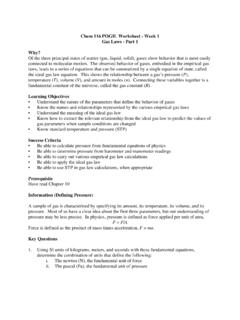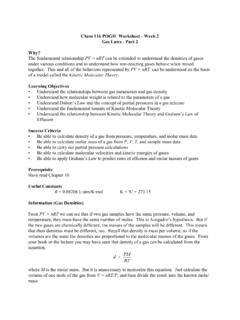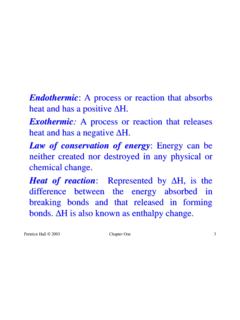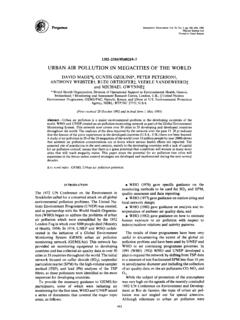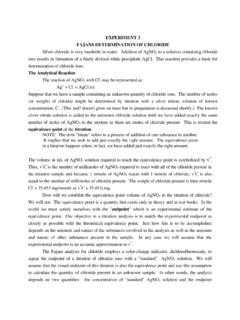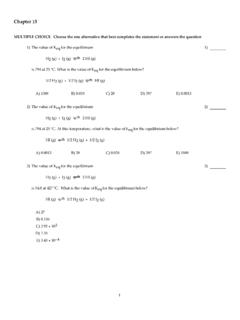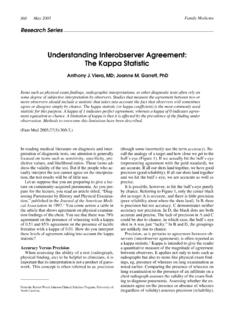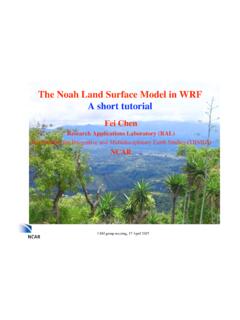Transcription of Chapter 14 Chemical Kinetics
1 Chemistry, The Central Science, 10th edition Theodore L. Brown; H. Eugene LeMay, Jr.;. PDF Created with deskPDF PDF Writer - Trial :: and Bruce E. Bursten Chapter 14. Chemical Kinetics Chemical Kinetics 1. Kinetics PDF Created with deskPDF PDF Writer - Trial :: Chemical Kinetics is the study of the rate at which a Chemical process occurs. Besides information about the speed at which reactions occur, Kinetics also sheds light on the reaction mechanism (exactly how the reaction occurs). Chemical Kinetics 2. Factors That Affect Reaction Rates PDF Created with deskPDF PDF Writer - Trial :: physical State of the Reactants In order to react, molecules must come in contact with each other. If the reaction is happening between a solid and a liquid it will react only on the surface.
2 The more homogeneous the mixture of reactants, the faster the molecules can react. Chemical Kinetics 3. Factors That Affect Reaction Rates PDF Created with deskPDF PDF Writer - Trial :: Concentration of Reactants As the concentration of reactants increases, so does the likelihood that reactant molecules will collide. Chemical Kinetics 4. Factors That Affect Reaction Rates PDF Created with deskPDF PDF Writer - Trial :: Temperature At higher temperatures, reactant molecules have more kinetic energy, move faster, and collide more often and with greater energy. Chemical Kinetics 5. Factors That Affect Reaction Rates PDF Created with deskPDF PDF Writer - Trial :: presence of a Catalyst Catalysts speed up reactions by changing the mechanism of the reaction.
3 Catalysts are not consumed during the course of the reaction. Chemical Kinetics 6. Reaction Rates PDF Created with deskPDF PDF Writer - Trial :: Rates of reactions can be determined by monitoring the change in concentration of either reactants or products as a function of time. Chemical Kinetics 7. Reaction Rates PDF Created with deskPDF PDF Writer - Trial :: C4H9Cl(aq) + H2O(l) C4H9OH(aq) + HCl(aq). In this reaction, the concentration of butyl chloride, C4H9Cl, was measured at various times. Chemical Kinetics 8. PDF Created with deskPDF PDF Writer - Trial :: The average rate of the reaction over each interval is the change in concentration divided by the change in time: [ X ]t2 - [ X ]t1 [X].. Average rate = =. t 2 -t1 t [C4H9Cl].
4 Average rate = t Chemical Kinetics 9. Reaction Rates PDF Created with deskPDF PDF Writer - Trial :: C4H9Cl(aq) + H2O(l) C4H9OH(aq) + HCl(aq). [ ] - [ ] Average rate = =- = x 10-4. 50-0 50. Chemical Kinetics 10. Reaction Rates PDF Created with deskPDF PDF Writer - Trial :: C4H9Cl(aq) + H2O(l) C4H9OH(aq) + HCl(aq). Note that the average rate decreases as the reaction proceeds. This is because as the reaction goes forward, there are fewer collisions between reactant molecules. Chemical Kinetics 11. PDF Created with deskPDF PDF Writer - Trial :: calculate the average rate of appearance of B. over the time interval from 0 to 40 s. Chemical Kinetics 12. Reaction Rates PDF Created with deskPDF PDF Writer - Trial :: C4H9Cl(aq) + H2O(l) C4H9OH(aq) + HCl(aq).
5 A plot of concentration vs. time for this reaction yields a curve like this. The slope of a line tangent to the curve at any point is the instantaneous rate at that time. Chemical Kinetics 13. Reaction Rates PDF Created with deskPDF PDF Writer - Trial :: C4H9Cl(aq) + H2O(l) C4H9OH(aq) + HCl(aq). All reactions slow down over time. Therefore, the best indicator of the rate of a reaction is the instantaneous rate near the beginning. Chemical Kinetics 14. Average vs. instantaneous rxn PDF Created with deskPDF PDF Writer - Trial :: rate Average rxn rate change of Chemical concentration .. between beginning of rxn and end [A]. rate of reaction (rate) = =. total time elapsed t Instantaneous rxn rate (tangent to curve). change of Chemical concentration.
6 Over a short period of time rate of reaction (rate) = = [A]. the short time elapsed t Usually in chemistry, we are interested in the instantaneous rxn rate at the very beginning (at t = 0) Chemical Kinetics INITIAL REACTION RATE 15. Average vs. instantaneous rxn rate PDF Created with deskPDF PDF Writer - Trial :: NaHCO3 + citric acid --> sodium citrate + H2O + CO2. initial [A] = 1 tablet 2 initial [A] = 2 tablets Instantaneous rate at t = 0. concentration (tablet/100 mL). (initial rate) Average rate 1. 0. 0 1 2. Chemical time (minutes) Kinetics 16. Comparing concentrations of chemicals in a reaction PDF Created with deskPDF PDF Writer - Trial :: A --> B A --> 2 C. [A] 2. 2. [B]. [A]. [C]. co n cen tration (m ol/L ). concentration (m ol/L).
7 1 1. 0 0. 0 1 2 0 1 2. Chemical time (hours) time (hours) Kinetics 17. What we're after in Kinetics PDF Created with deskPDF PDF Writer - Trial :: We want to be able to understand and predict how much reactants remain (or products get formed) in a certain amount of time Change with time is rate Rate means calculus must be used, so we need to be careful which rate we are talking about We will use instantaneous rate at the start of a reaction (initial rate). Several factors affect the rate of a reaction Initial concentration Temperature Amount of reactant exposed (surface area). presence of a catalyst A theory (equations) that predicts Kinetics must explain these Chemical Kinetics 18. calculate the instantaneous rate of disappearance of C4H9Cl at t = 0 (the initial rate).
8 PDF Created with deskPDF PDF Writer - Trial :: Chemical Kinetics 19. Determine the instantaneous rate of disappearance of C4H9Cl at t = 300 s. PDF Created with deskPDF PDF Writer - Trial :: Chemical Answer: 10 4 M/s Kinetics 20. Reaction Rates and Stoichiometry PDF Created with deskPDF PDF Writer - Trial :: C4H9Cl(aq) + H2O(l) C4H9OH(aq) + HCl(aq). In this reaction, the ratio of C4H9Cl to C4H9OH is 1:1. Thus, the rate of disappearance of C4H9Cl is the same as the rate of appearance of C4H9OH. - [C4H9Cl] [C4H9OH]. Rate = =. t t Chemical Kinetics 21. Reaction Rates and Stoichiometry PDF Created with deskPDF PDF Writer - Trial :: What if the ratio is not 1:1? 2 HI(g) H2(g) + I2(g). in such a case , 1 [ HI ] [H2 ] [ I2 ]. Rate = - = =.
9 2 t t t Chemical Kinetics 22. Reaction Rates and Stoichiometry PDF Created with deskPDF PDF Writer - Trial :: To generalize, then, for the reaction aA + bB cC + dD. 1 [A] 1 [B] 1 [C] 1 [D]. Rate = = = =. a t b t c t d t Chemical Kinetics 23. Key points about Kinetics so far PDF Created with deskPDF PDF Writer - Trial :: Study the vocabulary Reaction rate has weird units Be clear whether you are talking about average reaction rate or instantaneous reaction rate The equations which we will study all talk about instantaneous reaction rate, most easily measured at the beginning of a reaction (initial rate). Relating rates at which products appear (+) and reactants disappear (-) has to do with inverse stoichiometric coefficients Reaction rate depends on several factors: initial concentration, temperature, surface area of reactants exposed, presence of a catalyst Chemical Kinetics 24.
10 (a) How is the rate at which ozone disappears related to the rate at which oxygen appears in the reaction PDF Created with deskPDF PDF Writer - Trial :: (b) If the rate at which O2 appears, [O2] / t, is 10 5 M/s at a particular instant, at what rate is O3 disappearing at this same time, [O3] / t? Chemical Kinetics 25. SAMPLE EXERCISE continued PDF Created with deskPDF PDF Writer - Trial :: The decomposition of N2O5 proceeds according to the following equation: If the rate of decomposition of N2O5 at a particular instant in a reaction vessel is 10 7 M/s, what is the rate of appearance of (a) NO2, (b) O2? Answers: (a) 10 7 M/s, (b) 10 7 M/s Chemical Kinetics 26. Concentration and Rate PDF Created with deskPDF PDF Writer - Trial :: One can gain information about the rate of a reaction by seeing how the rate changes with changes in concentration.
